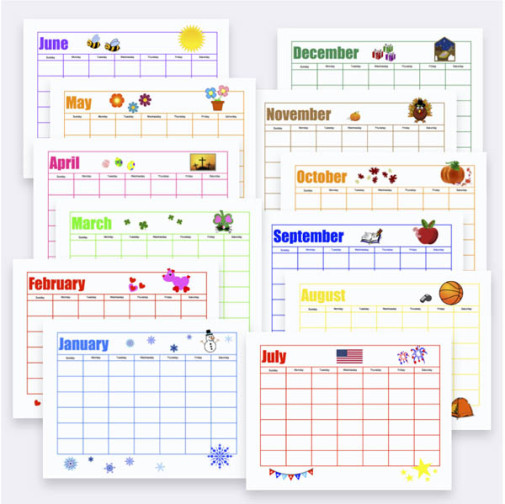We use cookies to make your experience better. To comply with the new e-Privacy directive, we need to ask for your consent to set the cookies. Learn more.
Reading Complete Calendar
Blank calendar pages printed on heavyweight paper with colorful accents.
Reinforce daily calendar skills with this colorful, monthly-themed calendar that includes one 8.5 x 11 inch page for each month of the year. The calendar is printed without any dates so that the child can fill in the dates. The completed pages can either be hung on a wall or poster board or put in the binder.
"Complete" is a big goal, and this program not only lives up to that name, but does so with a clear Christian message and user-friendly, inviting materials. Integrated with quality children's literature (fiction and non-fiction), phonics instruction is systematic and coupled with introductory language arts skills (spelling, punctuation, grammar, handwriting, and reading comprehension). The sequential mastery format means you could possibly move through the typical K-1 skills in one long-ish school year (169 daily lessons), but more likely you will want to spread them out over two years. The program is self-paced which means you can pause and reinforce if the daily lesson pacing is too fast for your student. In fact, the author encourages practicing the lessons for more than one day. If you are familiar with the Kindergarten and First Grade Complete programs, note that this program contains the reading/language arts portion of those complete curriculum programs, although in this format it can easily be used with any curriculum materials you are currently using.
The Teacher Manuals (five levels) each include daily lesson plans (32-36 lessons), step-by-step instructions, student workbook pages (reproducible), reading practice pages, activities, enrichment activities, handwriting guidelines, documentation of skills taught, and appendices with additional resources (literature and materials lists). "Easy to use" is obvious from the very beginning. Instructional sequences for teaching a new skill, reviewing a skill, and even for encouragement are provided. Each lesson lists materials needed and skills to be covered. The lessons are straightforward and lightly scripted, covering review, new skill instruction, reading practice, and reinforcement in the forms of flashcards, games, activities, and worksheets. Worksheets are usually a single (occasionally two) double-sided page and have enough color to make them interesting but not distracting. All answers are provided. Read-aloud books (to be purchased separately or checked out from your local library) are integrated into each lesson often and provide the basis for language arts instruction. Complete list of Read Aloud Books are listed below. Please note some titles are Out of Print (OOP). Handwriting is a pleasant blend of the Zaner-Bloser and D'Nealian methods. Daily materials needed are the various sets of flashcards, the worksheets, and basic school supplies (scissors, crayons, pencils, etc.). Various other household items (i.e. shoebox, baking ingredients, plastic eggs, balloons, etc.) are sometimes required for lesson activities. Bundles include the Teaching Manual(s) (three-ring binder which includes student workbook pages and reading practice pages) plus whatever sets of flashcards or games are needed for the level(s). Some items are also sold individually. Student Workbook Refill Pages, which include the student workbook pages and the reading practice pages, are available for additional students. ~ Janice
Level A skills: recognize and write uppercase and lowercase letters and know their sounds, develop left-to-right and top-to-bottom orientation, beginning level sight words (11), basic color words (11), number words one-ten, basic shape words (9), ordinal number words first-tenth, blend and read short vowel words, beginning word families, read sentences with fluency and inflection, understand sentence-ending punctuation, understand basic capitalization, singular nouns, and write clearly and effectively. 35 lessons.
Level B skills: Review/expand level A skills, consonant/vowel blending, long vowels, ow/ou words, write sentences, recognize basic sight words, identify/use rhyming words, understand literature written in a variety of genres, develop listening comprehension and narration skills, read orally with fluency and inflection, capitalization, sentence punctuation, adding suffixes, singular/plural nouns, understand/recognize synonyms and antonyms, alphabetical order, contractions, listen/interpret/write poetry, create a riddle, and descriptive narration. 36 lessons.
Level C skills: review/expand Levels A and B skills, read (short/long vowel words, words with consonant blends, double vowels, prefixes/suffixes), write/use possessive nouns, literal/inferential comprehension, adding suffixes, identify homophones, identify/use pronoun/contractions/compound words, syllabification, memorize/recite Bible passage, manners, listen/follow directions, learn about artist/works of art, and more. 32 lessons.
Level D skills: Review/expand Levels A, B, & C skills; apply spelling/phonics concepts through written practice; write clearly/effectively; understand story sequence; recognize/understand personification, abbreviations, possessive pronouns, and alliteration; memorize/recite Bible passage and poem; read/use map; learn about famous authors; and more. 34 lessons.
Level E skills: Review/expand Levels A, B, C, & D skills, identify root words, demonstrate ability to express ideas, write a friendly letter using proper formatting, recognize onomatopoeia, write a cinquain, recognize cause/effect relationships, understand verbal and nonverbal communication, demonstrate the ability to read a calendar, and more. 32 lessons.
| Product Format: | Other |
|---|---|
| Grades: | K-2 |
| Brand: | Homeschool Complete |
| Length in Inches: | 8.5 |
| Width in Inches: | 11 |
| Height in Inches: | 0.125 |
| Weight in Pounds: | 0.15 |
Be the first to review this item

